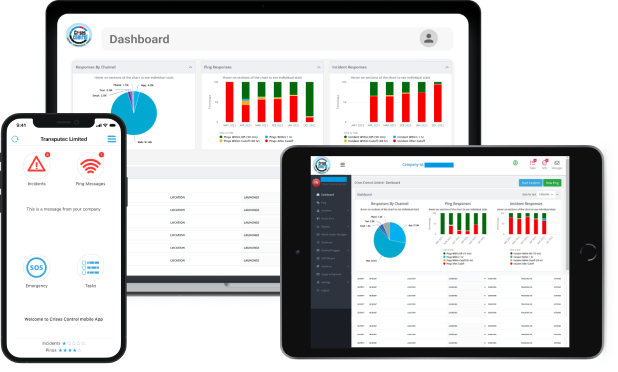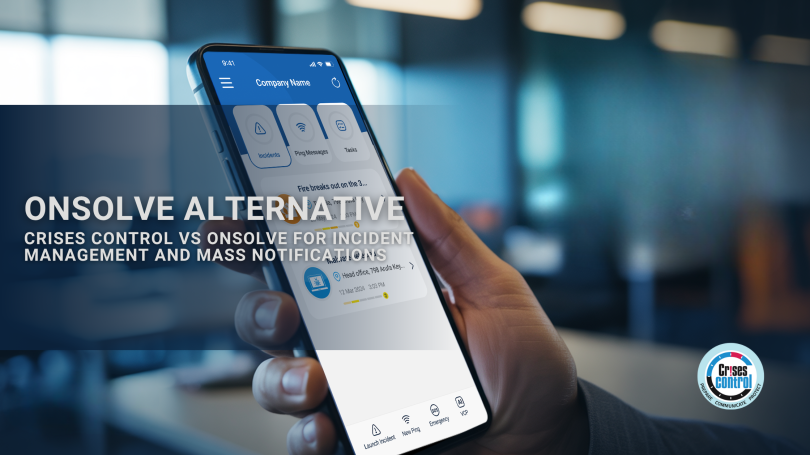When something goes wrong in your organisation, how quickly and clearly you respond can make all the difference. Whether it’s a system outage, a security breach, or a weather-related disruption, delays or miscommunication can cause real damage: financially, operationally, and reputationally.
Many companies rely on platforms like OnSolve to manage critical communications and coordinate their response. But increasingly, organisations are looking for an alternative that’s easier to use, more flexible, and better aligned with their regional needs, especially across the UK and Europe.
If you’re comparing options, this blog will help you understand how Crises Control offers a more agile and cost-effective approach to incident management and mass notification, without compromising on reliability or compliance.
Why Do Organisations Look for an OnSolve Alternative?
OnSolve is well known in the emergency communication space, particularly in the US. But no platform suits every organisation. When decision-makers start exploring other options, it’s often due to a few recurring challenges:
- Complex or unclear pricing models
- Support that’s based in a different time zone
- A lack of flexibility when configuring alerts or workflows
- Limited options for integration with existing tools
- US-centric compliance that doesn’t fully support UK/EU regulations
These aren’t deal-breakers for every business, but they can become serious pain points, especially for teams operating in regulated sectors or across multiple regions.
If your platform makes things more complicated when speed and clarity are essential, it’s time to consider a different approach.
What Is the Best Alternative to OnSolve?
If you’ve been asking yourself this question, the answer depends on what your organisation needs from a critical communications platform.
You might be looking for:
- A more transparent and scalable pricing structure
- Tools that are easier for your team to use during high-pressure events
- Full control over who gets notified, when, and how
- Support that understands your business and speaks your language
- Built-in tools to help manage the incident from start to finish
Crises Control ticks these boxes. It combines mass notification software with a fully integrated incident management platform, so you can both alert people and manage the response in real time.
It’s built for organisations that need fast, reliable communications, but don’t want to be locked into a rigid system that doesn’t evolve with their needs.
What Sets Crises Control Apart?
1. Integrated Incident Management
Crises Control does more than send alerts. It helps you take control of the entire incident lifecycle.
You can set up pre-defined workflows for different types of events, assign tasks to teams, and track progress as things unfold. This means you’re not scrambling to coordinate people or decisions during a crisis, it’s already planned.
Features include:
- Customisable workflows based on incident type
- Task tracking and automated updates
- Document storage for response plans and checklists
- Post-incident reports for audit and learning
Unlike platforms that treat messaging and incident handling as separate functions, Crises Control brings them together in one place. That reduces confusion and gives everyone clarity on what to do next.
2. Multi-Channel Mass Notifications
In an emergency, your message needs to reach people wherever they are, on the device they’re most likely to check.
Crises Control supports notifications through:
- SMS
- Voice calls
- Mobile app push alerts
- Desktop pop-ups
- Web portal messages
- Microsoft Teams
You can also create message templates in advance, so you’re not wasting time writing from scratch. Messages can be localised by language and location, and the system logs who received and acknowledged them.
3. Flexible, Transparent Pricing That Scales with You
One of the common challenges with enterprise software is navigating unclear pricing or being forced to pay for features you don’t need. Crises Control takes a different approach. The platform is modular, so you only pay for the features your organisation actually uses. Pricing is based on the number of users, making it easy to manage costs as your team grows.
This structure gives you full control over your budget while allowing the platform to scale alongside your business. Whether you’re supporting a small response team or a global workforce, Crises Control adapts to your size and needs without locking you into unnecessary costs.
4. Built for the UK and Global Compliance
For UK-based organisations or those working across Europe, compliance with data protection regulations like GDPR is not optional.
Crises Control hosts data in ISO 27001-certified UK and EU data centres, giving you full control over data sovereignty. It also supports multilingual alerts and custom fields, which helps ensure consistent communication with diverse teams.
This contrasts with platforms focused on US compliance models, which might not fully align with your obligations under UK or EU law.
5. Fast Deployment and Easy Integration
Crises Control integrates with tools you already use, including:
- Microsoft Azure Active Directory
- ServiceNow
- SAP
- Okta
- Open APIs for custom workflows
Setup is straightforward, and most organisations are up and running in a matter of days. There’s no long-winded training programme. The platform is designed to be intuitive, with full support from a UK-based team.
Who Uses Crises Control?
Crises Control is trusted by organisations across a wide range of industries and regions. Clients include companies in oil and gas, manufacturing, education, hospitality, law, healthcare, aviation, logistics, and stadium operations. From high-risk environments to customer-facing industries, the platform supports teams that need to act quickly, communicate clearly, and stay compliant.
It is used by businesses and public sector bodies in the UK, USA, Canada, Europe, the Middle East, Africa, Australia, and New Zealand. Whether managing incidents across a single site or coordinating response at scale, Crises Control helps ensure that teams have the tools they need to stay in control during critical events.
The platform is especially valued in sectors where downtime is costly, operations are complex, and regulatory requirements are strict. Many clients have replaced legacy systems that couldn’t keep up with their evolving needs. With Crises Control, they’ve gained a more flexible, responsive, and future-ready approach to resilience.
Real-World Use Case Example
Public Sector Organisation in the UK
A local government agency needed a way to notify thousands of staff and contractors about urgent service disruptions. Their previous system had limited reach, inconsistent delivery, and no way to manage the response beyond the initial alert.
After switching to Crises Control, they built automated workflows that triggered messages based on incident type, including fire alerts, service failures, and extreme weather. Staff receive updates through the channel most relevant to them, and department heads can monitor and manage the response in real time.
The outcome: faster coordination, less confusion, and a more resilient operation.
Conclusion: A Smarter Way to Manage Critical Events
Choosing the right platform for incident management and mass communication is about more than just sending messages. It’s about giving your team the tools they need to act quickly, communicate clearly, and maintain control during uncertain moments.
If your current platform doesn’t support that, it’s time to consider an alternative that does.
Crises Control offers a practical, flexible solution that fits the real needs of organisations in the UK and beyond. It gives you confidence that when something goes wrong, your people will know what to do, where to go, and how to stay safe.
Ready to see how it works?
Contact us today to schedule a free, no-obligation demo. Find out how Crises Control can help your organisation stay connected, compliant, and in control, no matter what happens next.
Request a FREE Demo

